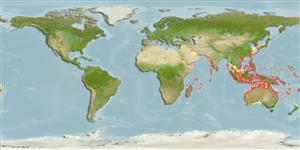>
Eupercaria/misc (Various families in series Eupercaria) >
Labridae (Wrasses) > Xyrichtyinae
Etymology: Iniistius: Latin, in = in + Greek, istion = sail.
More on author: Bleeker.
Environment: milieu / climate zone / depth range / distribution range
Ecología
marino asociado a arrecife; rango de profundidad ? - 64 m (Ref. 37816), usually 6 - 15 m (Ref. 90102). Tropical
Indo-West Pacific.
Tamaño / Peso / Age
Maturity: Lm ? range ? - ? cm
Max length : 26.0 cm TL macho / no sexado; (Ref. 48636)
Short description
Claves de identificación | Morfología | Morfometría
Espinas dorsales (total) : 9; Radios blandos dorsales (total) : 12; Espinas anales: 3; Radios blandos anales: 12. Identified by the thin but distinct blue line from the front of the eye to end of mouth and large individuals by the black elongate spot at the end of the anal fin (Ref. 48636).
Occurs on upper part of sand and mud banks, usually on reef flat areas, just before sloping down in depths from 7 m down to about 15 m. Found in spread out groups, often with X. pentadactylus in the same general area, but this species grows much larger and dominates (Ref. 48636). Dives into sand to sleep safely at night or to hide when alarmed (Ref. 90102). But the biggest males swim over large areas and move away quickly when approached by divers rather than diving into the bottom (Ref. 48636).
Life cycle and mating behavior
Madurez | Reproducción | Puesta | Huevos | Fecundidad | Larva
Distinct pairing during breeding (Ref. 205).
Masuda, H., K. Amaoka, C. Araga, T. Uyeno and T. Yoshino, 1984. The fishes of the Japanese Archipelago. Vol. 1. Tokai University Press, Tokyo, Japan. 437 p. (text). (Ref. 559)
IUCN Red List Status (Ref. 130435: Version 2024-1)
Threat to humans
Harmless
Human uses
Pesquerías: comercial
Herramientas
Special reports
Download XML
Fuentes de Internet
Estimates based on models
Preferred temperature (Ref.
123201): 23.1 - 29.3, mean 28.2 °C (based on 2427 cells).
Phylogenetic diversity index (Ref.
82804): PD
50 = 0.5000 [Uniqueness, from 0.5 = low to 2.0 = high].
Bayesian length-weight: a=0.01047 (0.00408 - 0.02689), b=3.06 (2.84 - 3.28), in cm total length, based on LWR estimates for this (Sub)family-body shape (Ref.
93245).
Nivel trófico (Ref.
69278): 3.5 ±0.5 se; based on size and trophs of closest relatives
Resiliencia (Ref.
120179): Medio, población duplicada en un tiempo mínimo de 1.4-4.4 años (Preliminary K or Fecundity.).
Fishing Vulnerability (Ref.
59153): Low vulnerability (16 of 100).
